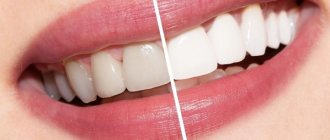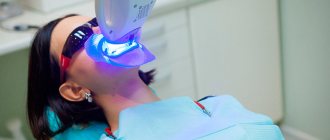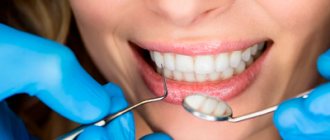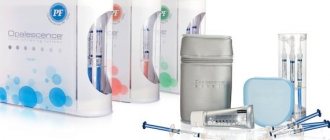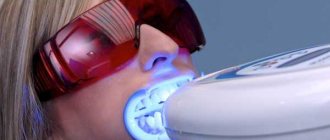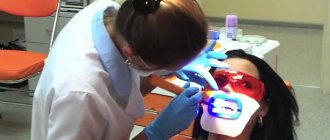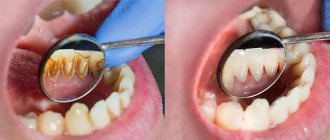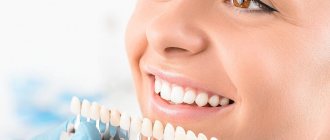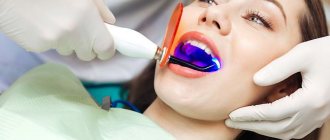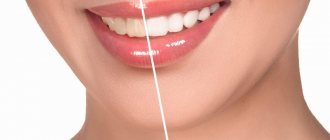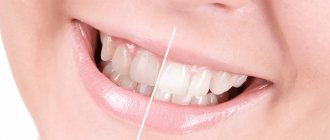Author: Brodsky Sergey Evgenievich Deputy Chief Physician, Candidate of Medical Sciences in the specialties: dentistry and medical microbiology Chemical teeth whitening, as a professional method, is not the most effective and gentle. Nevertheless, this method of teeth whitening exists and is in demand. What is the difference between home and office (at the dentist) chemical teeth whitening, what possible complications and other details are discussed in this article.
- Why do adults' teeth darken?
- Cleaning and chemical teeth whitening
- Home chemical teeth whitening
- Chemical teeth whitening at the dentist
- Damage from chemical teeth whitening
- Prices for chemical teeth whitening in Moscow
Deputy chief physician
Brodsky Sergey Evgenievich
Sign up for a free consultation
+7
Why do adults' teeth darken?
Answering the question why teeth darken in adults, there are several key points:
- Over time, the thickness and transparency of the enamel decreases
- Dentin becomes sclerotic and pigmented
- Teeth lose their pulp due to caries and its complications.
- Due to the deposition of antibiotics and excess fluoride in the hard tissues of the tooth (tetracycline and fluorous teeth)
- Due to plaque and tartar accumulation and lack of good home oral hygiene
All of the above reasons lead to a decrease in the reflection of light falling on the teeth, which leads to a visual darkening of the dentition.
Cleaning and chemical teeth whitening
Quite often, patients believe that teeth cleaning and chemical teeth whitening are the same thing. In fact, this is not true.
Brushing your teeth cleanses the enamel using mechanical and ultrasonic action. If the enamel of a tooth is worn away and yellow dentin shows through, then no procedure other than bleaching will change this color. In other words, cleaning returns the teeth to their original color, and whitening brightens teeth using chemical reactions aimed at oxidizing the organic elements of dentin. Therefore, it is necessary to distinguish between cleaning teeth from plaque and tartar and lightening teeth using different whitening options.
As a rule, professional scaling always precedes in-office dental whitening.
Home chemical teeth whitening
During home chemical whitening, under the supervision of a dentist, the following activities are carried out:
- Silicone impressions are taken for the patient and customized mouth guards are made.
- Before the teeth whitening procedure, professional removal of dental plaque is carried out.
- Remotherapy and treatment of carious teeth are carried out
- A whitening gel is selected and recommendations for its use are given.
- After the whitening is completed, the teeth are coated with protective varnishes and gels.
There are daytime and nighttime home chemical bleaching, and there are also differences in the length of time the aligners with gel are worn, from 1 to 8 hours.
Chemical teeth whitening at the dentist
In the dentist's office, chemical teeth whitening proceeds in the following sequence:
- Professional oral hygiene is carried out with the removal of plaque and tartar
- Custom mouth guards are made
- Preparatory dental remotherapy is carried out
- Whitening gel is more concentrated than in home procedures.
- Removing whitening gel residue from teeth
- Covering bleached teeth with protective preparations
- Prescription of home whitening oral hygiene
Thus, color correction of teeth with the direct participation of a dentist performing chemical whitening is similar to do-it-yourself home whitening.
Damage from chemical teeth whitening
Damage to enamel and dentin during chemical tooth whitening is caused by the concentrated composition of the whitening gel contained in an individual tray.
In especially severe cases, this leads to the death of the pulp and the development of chemical pulpitis.
In some cases, after chemical dental whitening, teeth may react to thermal irritants. As a rule, to prevent such complications, dentists use remotherapy, select the optimal concentration of the whitening gel, and also perform protective insulation of lightened teeth using fluoridation.
Prices for chemical teeth whitening in Moscow
The price structure for chemical teeth whitening includes the following components:
- Cost of consumables;
- The cost of an individual mouth guard;
- Cost of preliminary removal of dental plaque;
- Preventive coating of already whitened teeth with fluoride preparations.
The cost of chemical teeth whitening is also affected by:
- dentist qualification;
- price segment in which the dental clinic operates.
In Moscow, one session of chemical teeth whitening starts from 5,000 rubles and can reach 25 thousand rubles.
Deputy Chief physician Sergey Evgenievich Brodsky
Sign up for a free consultation
+7
Just CALL US!
+7
We will answer any of your questions and will definitely help you!
Content:
- Why is there a need to use chemical teeth whitening?
- Is it possible to replace chemical bleaching with a professional hygiene procedure?
- Features of the chemical bleaching procedure 3.1. Whitening in the dentist's office 3.2. Whitening at home
- Should the procedure be trusted?
- Contraindications
When carrying out professional teeth whitening, chemical techniques can be used. Today it is not very popular among doctors and is not very well known to patients, but dental clinics are in no hurry to exclude it from the list of services. Sometimes there are clinical situations in which this particular method of lightening tooth enamel is the most effective.
Preparation and carrying out the procedure
Chemical teeth whitening has a number of contraindications, so the dentist initially diagnoses the patient’s oral cavity.
Any restorations in the bleaching area (veneers, fillings, crowns) do not allow such a bleaching process.
In addition, if the teeth in the area of whitening require treatment, then restoration of the health of the teeth is carried out first, and then only whitening.
Before applying the gel, the soft tissues of the tooth are fixed, and the gums are protected with a special film. After which the prepared composition is applied for 15-30 minutes. The concentration is determined individually.
It is extremely important that the process is led by an experienced cosmetologist, since if the gel is used incorrectly, there is a risk of damage to the oral mucosa and other problems.
Why is there a need to use chemical teeth whitening?
Enamel is characterized by such a property as the degree of transparency. For some people this indicator is higher, for others it is very low. In any case, everyone has transparent enamel. The color of the teeth is the result of applying all the layers one on top of the other:
- red pulp;
- yellow or gray dentin;
- white-blue transparent enamel.
Dentin is the inner layer. It absorbs pigments contained in food products. As a result, it gradually gets darker. On the outside, soft plaque and hard stone settle on the enamel. Under the influence of aggressive compounds, it becomes porous and also absorbs coloring compounds. Thus, over the course of a person's life, the color of his smile slowly changes for the worse.
How to whiten teeth at home?
Along with professional whitening, there are techniques that can be used at home. The main ones:
- Abrasive pastes. Small particles in their composition help remove soft plaque, and reflective components visually make teeth lighter.
- Whitening trays. There are options here: buy ready-made trays and use special gels for home whitening, which can be purchased at most pharmacies, or order individual production of whitening trays and the development of a personal whitening composition according to indications. The second option is more preferable because it solves the patient’s specific problems.
- Whitening strips. They are impregnated with a chemical composition that penetrates the structure of tooth enamel and affects pigmented fragments.
It should be borne in mind that home methods of teeth whitening give a less pronounced effect and take time to obtain results.
As for the cost of procedures, the price is influenced by many factors - starting with the choice of technique and ending with the volume of manipulations. You can calculate the cost during a preliminary consultation. Also, if necessary, you can always contact our dental laboratory for individual development of whitening trays and preparation of a brightening gel.
Is it possible to replace chemical bleaching with a professional hygiene procedure?
Today, doctors never tire of talking about the capabilities of an ultrasonic scaler and the Air-Flow technique.
With the help of these technologies, you can remove all tartar and plaque in just one visit to the dentist. As a result, the enamel becomes much lighter, and the appearance of the smile is transformed. But professional hygiene does not have the same capabilities as chemical bleaching. It only affects the outer layer of units. If the color of the dentin is changed, the ultrasonic scaler will not be able to lighten it.
How can you whiten your teeth?
In dentistry, there are several types of teeth whitening:
Mechanical bleaching. We are talking about the use of such technologies, as a result of which it is possible to clean tooth enamel from soft plaque and hard dental deposits. There is no direct effect on tooth enamel tissue. Mechanical teeth whitening can be performed using the following techniques:
- Ultrasonic cleaning. Under the influence of directed ultrasound waves with different vibration frequencies, tartar is destroyed. As a result, the enamel is cleaned and becomes a little lighter.
- Air Flow technique. Removal of soft plaque occurs by exposure to directed air flows supplied under high pressure. In this case, the air stream contains small abrasive particles; soda is usually used for this. The Air Flow method is effective against soft dental plaque, polishes the surface of the teeth well, due to which food debris and bacteria accumulate less on the enamel.
Chemical bleaching. The method is based on the use of special chemical compounds and their activators. Ultraviolet, laser or thermal radiation are used as the latter. Under the influence of activators, chemical compounds begin to release active oxygen, which penetrates into the tissue of tooth enamel and lightens pigmented areas. Depending on the specific method, chemical teeth whitening can lighten the enamel by 10-12 tones. There are several technologies for such whitening:
- Photobleaching, or ZOOM. The chemical compound is a gel with a high content of hydrogen peroxide. Under the influence of ultraviolet light, the drug releases active oxygen, which penetrates the enamel structure and lightens pigmented areas.
- Laser whitening. The role of the activator in this case is played by a laser beam, which heats the active substance of the gel and promotes the release of oxygen. The chemical reaction proceeds at high speed, the exposure time is minimal, so the enamel is not injured.
Typically, mechanical enamel lightening precedes chemical methods of teeth whitening and is a preparatory stage.
Features of the chemical whitening procedure
In fact, all available methods of professional whitening are chemical. After all, when using them, dentin is treated with special lightening compounds containing hydrogen peroxide and other whitening components. The solution can work independently or under the influence of a lamp or laser beam.
In the case of chemical bleaching, no catalyst is used - only a chemical gel. The technique can be used both at home and in the dental office. Of course, in the second case it is more effective.
Whitening in the dentist's office
If the lightening is carried out by a doctor, then on the appointed day the doctor applies a highly concentrated lightening preparation to the isolated dentition. After a certain period of time it is washed off. As a result, uniform dentin lightening is achieved.
If after the first session the desired effect is not achieved, the solution can be reapplied immediately. It is important here that a person does not experience discomfort associated with the very high sensitivity of the enamel. As a rule, in one procedure it is possible to lighten the dentition by 5-7 tones. This is a pretty good result.
Whitening at home
If the client wants to fight for the beauty of his smile on his own, he is given individual aligners and a special dental preparation. At night you need to put gel in the mouth guard and put it on your teeth. The procedure must be repeated for a week or more.
With home treatment, there is a risk of uneven lightening of the enamel. This may be due to the structure of the teeth and inaccurate distribution of the gel. It is very important that a person strictly adheres to the holding time specified by the dentist. Some people think that if they wear a mouth guard longer, they will be more likely to get a Hollywood smile. In fact, with such an attitude to therapy, they will not get glowing white teeth, but high sensitivity, carious lesions and inflammation of the gums.
Where to contact?
The price for chemical teeth whitening varies significantly depending on the class of the clinic. The right decision is to choose the middle segment, where prices are not particularly high, and the staff is experienced and qualified. The result is visible almost immediately. Your teeth will become 5-10 shades lighter. And the dream of a Hollywood smile will become a reality.
To prevent re-staining, it is recommended to limit your consumption of food products that have dyes, and also stop smoking (including hookahs).
Should the procedure be trusted?
Since no catalyst (ultraviolet radiation, laser) is used during therapy, overheating of the enamel is completely eliminated. This is a significant advantage of this clarification method. But if safety rules are not followed, pain may still occur.
That is why you should trust your health only to experienced and highly qualified doctors. It is better to completely abandon independent home manipulations.
Contraindications
People who want to improve the appearance of their smile using dental reagents are not always able to do so. Among the contraindications to the use of the described method of aesthetic dentistry:
- the presence of any artificial coverings on the front surface of the crowns - crowns, veneers, lumineers, etc.;
- opening of individual dentin zones;
- poor oral hygiene;
- the presence of untreated dental diseases, multiple caries;
- undergoing orthodontic treatment;
- breastfeeding period;
- allergies to dental medications that need to be used;
- diabetes;
- periodontal tissue diseases that require urgent treatment;
- increased tooth wear;
- presence of cracks on the crowns.
Also, aesthetic intervention is unacceptable if the color of the crown part has changed due to the installation of a filling. To choose the best option for lightening units, you should consult your doctor. The patient should not decide on the method of aesthetic therapy on his own.
